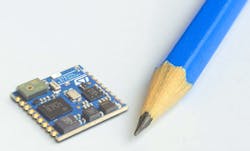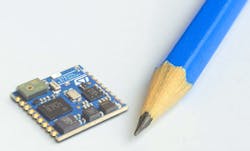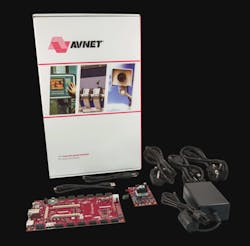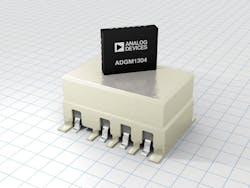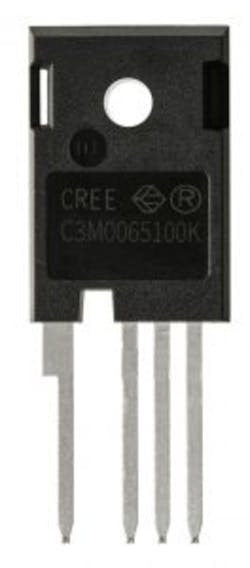Evaluation kits, reference designs offer a head start
When designing components including sensors, programmable SoCs, data converters, switches, power supplies, or RF power MOSFETs into your projects, evaluation boards, development platforms, and reference designs can provide a significant head start. Many manufacturers and distributors offer these products, as exemplified by several offerings released near the end of last year. Such offerings can get you up and running quickly and can even be part of your final product.
Consider, for example, the SensorTile, one of several sensor-related products introduced recently by STMicroelectronics. The company says the 13.5-mm x 13.5-mm SensorTile (Figure 1) currently is the smallest turnkey sensor board of its type, containing a MEMS accelerometer, a gyroscope, a magnetometer, a pressure sensor, and a MEMS microphone. With the onboard low-power STM32L4 microcontroller, it can be used as a sensing and connectivity hub for developing products such as wearables, gaming accessories, and smart-home or other Internet-of-Things devices.
Courtesy of STMicroelectronics
SensorTile has a complete Bluetooth low-energy transceiver including a miniature single-chip balun onboard as well as a set of system interfaces that support use as a sensor-fusion hub or as a platform for firmware development. It can be plugged to a host board, and when powered, it immediately starts streaming inertial, audio, and environmental data to ST’s BlueMS smartphone app that can be downloaded free from popular app stores.
With an onboard microcontroller and transceiver, the SensorTile might seem to serve as its own evaluation board or development platform. But ST also offers it as part of a complete $89 kit. The STEVAL-STLKT01V1 kit1 includes a cradle board, which carries the SensorTile core system in standalone or hub mode and which can be used as a reference design. The cradle board adds a humidity and temperature sensor, a micro-SD card socket, and a lithium-polymer battery (LiPo) charger, demonstrating how a complete prototype customized with extra functionality can be designed around the SensorTile core system.
The kit also includes an expansion board with an analog audio output, a micro-USB connector, and an Arduino-like interface that can be plugged into any STM32 Nucleo board to expand options for system and software development. Also included are a programming cable, a LiPo rechargeable battery, and a plastic case that provides a housing for the cradle, SensorTile, and battery combination.
The company says software development is fast and easy thanks to an ecosystem of APIs based on the STM32Cube hardware abstraction layer and middleware components, including the STM32 Open Development Environment. The system is fully compatible with the Open Software eXpansion Libraries (Open.MEMS, Open.RF, and Open.AUDIO) as well as with many third-party embedded sensing and voice-processing projects. Sample programs available in source code offer a starting point for evaluation and customization, including software for position sensing, activity recognition, and low-power voice communication.
SoC starter kit
Courtesy of Avnet
Avnet, a global technology distributor, is addressing programmable SoCs with its recently released UltraZed-EG starter kit, which provides a complete system for prototyping and evaluating designs based on the Xilinx Zynq UltraScale+ MPSoC (Multi-Processing System on Chip). The kit (Figure 2) bundles the new UltraZed-EG system on module (SOM) and carrier card and sells for $895.
The Avnet-designed UltraZed-EG SOM is a flexible, rugged SOM that packages all the necessary functions for an embedded processing system, including system and configuration memory as well as Ethernet and USB interfaces. The SOM provides designers of high-performance systems—in markets including industrial automation, smart energy, medical, digital signage, and security surveillance—with access to 180 user I/O pins and other resources.
“The Zynq UltraScale+ MPSoC delivers new levels of embedded SoC scalability and flexibility that are essential in next-generation applications, including wired and 5G wireless infrastructure, cloud computing, and the Industrial IoT,” said Nasser Poureh, director of technology, technical marketing, Avnet Electronics Marketing, in a press release. “With Avnet’s off-the-shelf UltraZed-EG SOM, supported by the Avnet UltraZed I/O carrier card, customers can not only build high-performance systems based on the Zynq UltraScale+ MPSoC device family with confidence, but they also will be able to cut system bring-up and debug time by half, while reducing overall system cost by 20% or more as compared to standard chip-down designs.”
“The UltraZed-EG SOM, I/O carrier card, and starter kit are a true representation of Avnet’s commitment to supporting their customers’ development needs with the Xilinx Zynq UltraScale+ MPSoC device family,” added Evan Leal, director of boards and kits product marketing at Xilinx. “The SOM element of the starter kit also is an excellent solution for helping users move more quickly from prototyping into production.”
The community-based Zedboard.org site offers additional design support for Xilinx programmable SoCs, including reference designs, documentation, training, and videos.
Wireless connectivity
Mouser Electronics, which describes itself as a new product introduction distributor with a wide selection of semiconductors and electronic components, recently announced that it now is stocking the nRF52840 Preview Development Kit (nRF52840-PDK) from Nordic Semiconductor. The nRF52840-PDK is a versatile single-board development kit for evaluating the nRF52840 SoC, a proprietary wireless connectivity device that supports several protocols to address smart-home, wearable, and other IoT applications.
The nRF52840-PDK includes four user-programmable buttons and LEDs, is hardware compatible with Arduino Uno R3-based shields, and features connector pins for all inputs and outputs, including a dedicated connector for the included external NFC antenna.
The nRF52840 SoC builds on the architecture of Nordic Semiconductor’s existing nRF52 Series SoCs to support complex Bluetooth low energy and other low-power wireless applications. The nRF52840 SoC uses a 64-MHz, 32-bit ARM Cortex-M4F processor employed on Nordic’s nRF52832 SoC plus a CPU with ample generic processing power as well as floating-point and DSP performance.
The nRF52840-PDK complies with the Bluetooth 5 specification that, coupled with increased maximum output power, enables the nRF52840 SoC to deliver Bluetooth low energy wireless connectivity with up to four times the range or up to twice the raw data bandwidth (2 Mb/s) compared with the Bluetooth low energy implementation of Bluetooth 4.2. In addition to Bluetooth 5, the nRF52840 SoC includes IEEE 802.15.4 capabilities for ZigBee and Thread-based smart-home technologies (see www.threadgroup.org). It also handles 6LoWPAN and standard Internet protocols. The nRF52840 SoC’s support for 802.15.4 extends its capability as an interoperable foundation technology for IoT and industrial wireless sensor networks using several different wireless technologies.
SAR ADCs
Linear Technology offers a variety of evaluation tools for its lineup of ICs. For example, its PScope system is a USB-based product-demonstration and data-acquisition system for Linear Technology’s high-performance ADCs and signal-chain receiver family. The system consists of a USB data-acquisition controller board that connects to a PC and to individual daughtercards for specific Linear Technology ADCs. Software collects and analyzes data in both the time and frequency domains and displays relevant parameters for the device being evaluated. PScope allows users to evaluate the SNR, SFDR, THD, and other key parameters quickly and easily. PScope also can perform more complicated calculations such as intermodulation distortion from a two-tone test or adjacent channel power ratios from a spread-spectrum signal.
The company’s 2395A-A demo board2 supports the recently introduced LTC2320-16, a 16-bit, 1.5-MS/s/channel, no-latency SAR ADC with eight simultaneously sampling channels providing a rail-to-rail input common-mode range. The LTC2320-16 features a flexible analog front end that accepts fully differential, unipolar, or bipolar analog input signals as well as arbitrary input signals, and it maintains an 82-dB SNR and a high CMRR of 102 dB when sampling input signals up to the Nyquist frequency. The wide input bandwidth of the LTC2320 allows the digitization of input signals up to the Nyquist frequency of 750 kHz.
The LTC2320-16 integrates a precision bandgap reference with low drift and guaranteed 20-ppm/°C maximum temperature coefficient into a small 55-mm² QFN-52 package, saving space in high-density designs. The internal reference can be overdriven by up to four separate external references for each pair of two channels to best suit the input range of the application.
The LTC2320-16 leads a family of 16-, 14-, and 12-bit SAR ADCs with single, dual, quad, and octal options sampling at up to 5 MS/s/ch. The entire family accepts 8.192-VPP to 10-VPP true differential inputs digitizing over a wide input common-mode range and requires no configuration for input signal type, ensuring flexibility in the input signal chain. The complete LTC2320 SAR ADC family offers 3.3-V or 5-V supply options and CMOS or LVDS high-speed SPI-compatible serial-interface options, suitable for a range of high-speed and space-constrained applications, including medical devices and battery-operated systems.
The 2395A-A demo board is configured for CMOS operation by default but can optionally be configured for LVDS operation. The demo board requires the DC890B USB data-acquisition controller for the PScope system.
MEMS switches
Courtesy of Analog Devices
Analog Devices, which announced last summer its intention to acquire Linear Technology in a transaction expected to close by the end of this June, also makes data converters and offers evaluation and development tools for them. But the company recently introduced a new class of components—including the ADGM1304 SP4T 0-Hz (DC) to 14-GHz switch,3 which comes in a 5-mm x 4-mm x 0.95-mm QFN package (Figure 3). Features include a five-contact gold-beam electrostatically actuated cantilever switch design with metal-hardened contacts. The switch is copackaged with a high-voltage, low-power drive IC.
To help you get started with the ADGM1304, the company offers the EVAL-ADGM1304 evaluation board, which comes fitted with connectors for RF and control signals as well as links to allow the user to control the operation of the switch and evaluate its performance.
Evaluating power converters
As for power supplies, Texas Instruments recently introduced what it calls the industry’s first fully integrated power-management solution for DDR2, DDR3, and DDR3L memory subsystems in automotive and industrial applications. The TPS54116-Q1 DC/DC buck converter is a 2.95-V to 6-V input, 4-A synchronous step-down converter with a 1-A peak sink/source DDR termination and buffered reference that reduces system size by up to 50% compared with discrete implementations, the company said. Designed for automotive applications such as infotainment, advanced driver assistance systems (ADAS), and instrument clusters, the TPS54116-Q1 also can power DDR memory in telecommunication, test-and-measurement, and factory-automation equipment.
For design support, TI offers the TPS54116-Q1EVM-830 evaluation module (EVM)5 as well as its WEBENCH online design environment. The EVM operates from a 2.95-V to 6-V input and delivers a 4-A DDR VDDQ output. The EVM includes an integrated 1-A VTT LDO output with onboard VTT sink and source switched load. The company also offers a reference design6 that can help you create an integrated, size-optimized power supply for an ADAS featuring the TPS54116-Q1 when using TI’s TDA3 system on chip.
And finally, the distributor Richardson RFPD recently announced the availability and full design support capabilities for the 1,000-V, 65-mΩ C3M0065100K silicon-carbide power MOSFET (Figure 4) from Wolfspeed. The device comes in an optimized four-lead TO-247-4 package with a separate driver source pin. This package provides lower switching losses with minimal gate-circuit ringing due to the Kelvin gate connection. It features a notch between the drain and source pins, which increases creepage distance to best support operation of higher voltage discrete devices. The current rating at 100°C is 22.5 A.
The device is optimized for electric-vehicle charging systems and three-phase industrial power supplies, and it addresses many power design challenges by offering low on-resistance, low output capacitance (60 pF), and low source inductance, thereby providing low switching and conduction losses.
The CRD-20DD09P-2 reference design is a 20-kW circuit offering a 700-VDC to 750-VDC input voltage, a 300-VDC to 700-VDC output voltage, and a greater than 45-W/inch3 power density. In addition to including eight C3M0065090D devices, the design includes four Wolfspeed C4D20120D SiC diodes, two Wolfspeed C3D10060A SiC diodes, and one Wolfspeed C2M1000170D power transistor. An on-demand webcast7 offers more information.
References
- STEVAL-STLKT01V1 SensorTile development kit, Data Brief, STMicroelectronics, November 2016.
- Demo Manual DC2395A, Linear Technology Corp., 2016.
- Nelson, R., “Instrument and chip vendors boost high-frequency test,” EE-Evaluation Engineering, January 2017, p. 12.
- EVAL-ADGM1304EBZ User Guide, UG-644, Analog Devices, 2016.
- TPS54116-Q1EVM-830 4-A, 1-A, SWIFT Regulator Evaluation Module, User Guide, Texas Instruments, August 2016.
- Automotive Power Reference Design for Low Power TDA3x Based Systems, TI Designs – TIDA-00530, Texas Instruments, 2015.
- “High-efficiency, Resonant DC/DC Converter for Fast EV Charger Designs,” On-Demand Webinar, Engineering 360, Oct. 20, 2016.
For more information
About the Author

Rick Nelson
Contributing Editor
Rick is currently Contributing Technical Editor. He was Executive Editor for EE in 2011-2018. Previously he served on several publications, including EDN and Vision Systems Design, and has received awards for signed editorials from the American Society of Business Publication Editors. He began as a design engineer at General Electric and Litton Industries and earned a BSEE degree from Penn State.
